Kashmiri pink chai is a gorgeous, blush-colored tea with a strong spiced flavor. This Kashmiri pink tea is traditionally slightly salty, but can be sweetened using date syrup or your favorite sweetener!
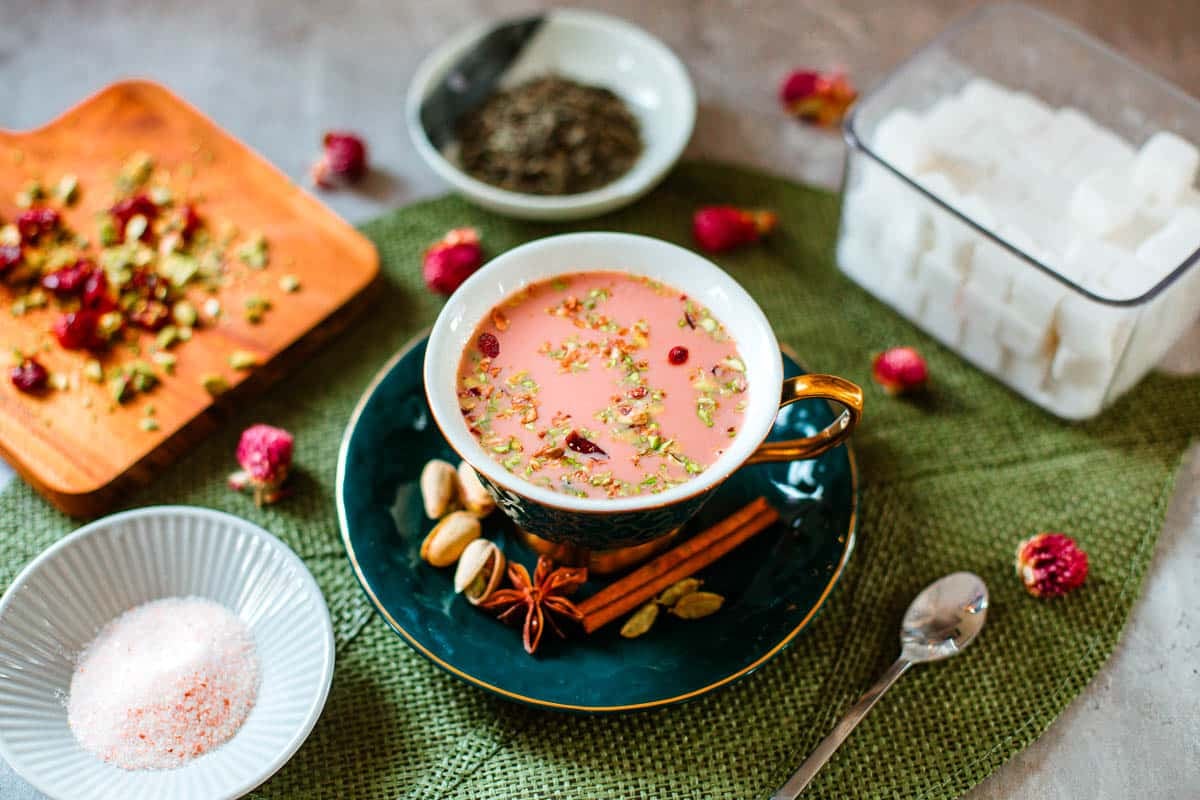
In addition to "Kashmiri chai", this tea goes by many names, such as noon chai, gulabi chai, and sheer chai, to name a few. "Sheer" comes from the Persian word "shir", which means "milk". "Noon", in several Indo-Aryan languages such as Kashmiri, Nepali, and Bengali, is the word for "salt", which hints at this pink tea's unique flavor profile.
While this salty Kashmiri pink tea may seem like an odd beverage by Western tastes, this drink is enjoyed daily amongst millions of people around the world! This recipe, however, is for the sweet version, taking inspiration from the Pakistani approach to Kashmiri chai!
Jump to:
☕️ What Is Kashmiri Chai?
The Science Behind It
First of all, let's start with why Kashmiri chai is pink. It may surprise you to learn that this brew is made with green tea leaves! The addition of an unexpected ingredient is what gives it that reddish tint - baking soda!
When combined in hot water, there's a chemical reaction between the sodium bicarbonate and the chlorophyll in the tea leaves that yields a deep burgundy liquid. The addition of milk lightens this beverage, giving it a lovely shade of pink.
To be more specific, the polyphenols (naturally occurring compounds found in all plants) in green tea are naturally yellow in color. The pH in green tea leaves is lower, or more acidic, than the more alkaline pH levels in baking soda.
Brewing the leaves extracts these yellow polyphenols (hence the yellow-ish color of regular green tea). The addition of baking soda changes the color of those extracted polyphenols before your very eyes! It's not magic, it's science!
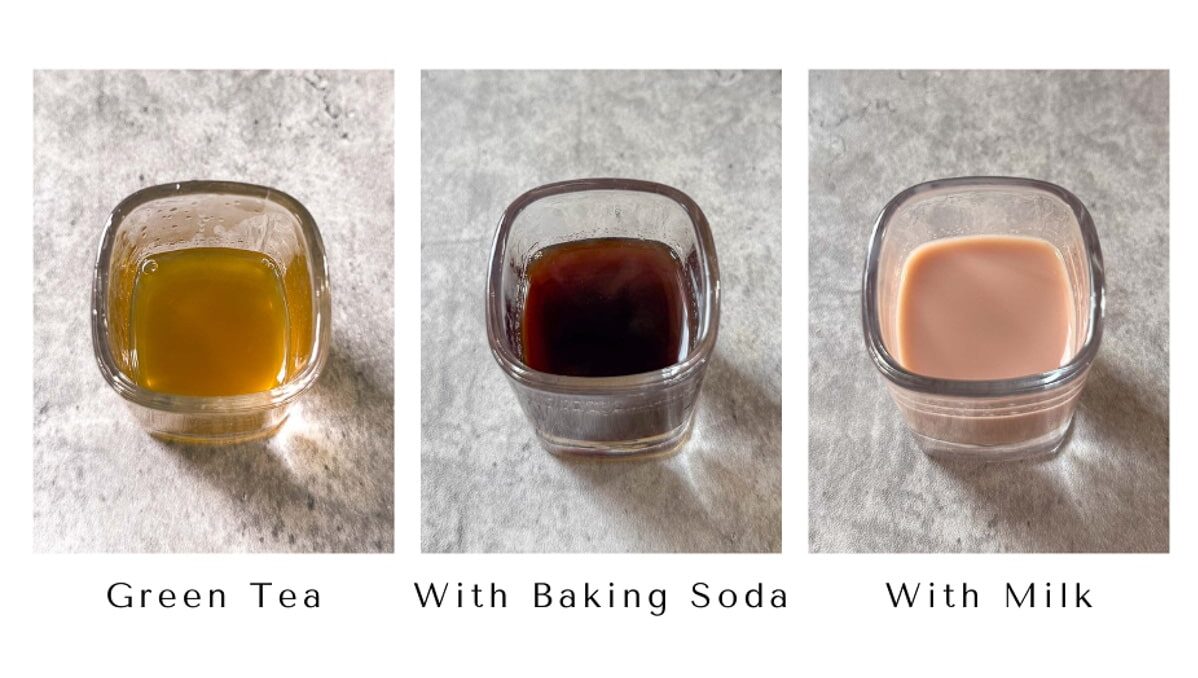
😍 Why You'll Love This Recipe
- Traditional Kashmiri pink chai is boiled in a samovar for at least an hour, then aerated by hand for several more hours! This recipe shortens the process while still honoring the tradition.
- Have you ever seen a more aesthetic brew? Enough said.
- Making this tea is like performing your own little science experiment in the kitchen - lots of fun for adults and children alike!
🔖 Ingredients & Substitutions
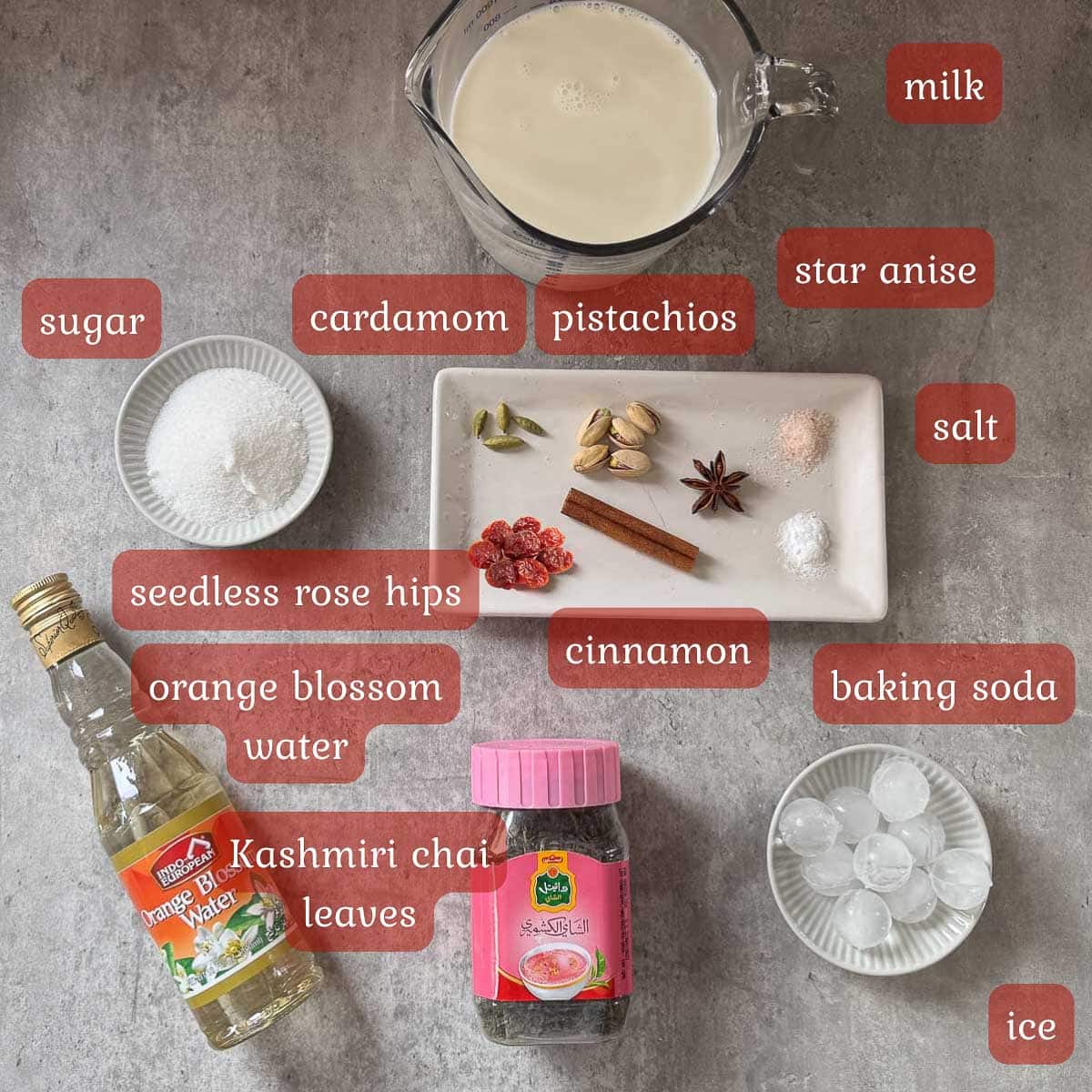
- Kashmiri green tea leaves: Or Chinese gunpowder green tea.
- Baking soda: This is what gives it that pink hue!
- Ice water: It has to be ice cold, or it won't have the same effect on the color.
- Milk: Use whole milk or substitute half & half or cream.
- Cardamom pods: You want green cardamom, not black. If you aren't sure what the difference is, check out this guide to black cardamom vs green cardamom.
- Spices: I use cinnamon and star anise, but you can also use saffron, nutmeg, and cloves.
- Salt: Pink Himalayan salt seemed appropriate, but sea salt will work as well!
- Sugar: I like to use granulated white or cane sugar, but you can use your preferred sweetener, or omit altogether if you want it salty.
- Orange blossom water: You can also use rose water or vanilla extract.
- Pistachios: Almonds work too.
- Seedless rosehips: To garnish. Culinary rose petals are another great option!
How To Make Kashmiri Pink Chai
Step 1: Add 2 cups of water to a medium saucepan, along with Kashmiri chai leaves, cardamom pods, star anise, and a cinnamon stick. Stir and bring to a boil. Meanwhile, prepare the ice water.
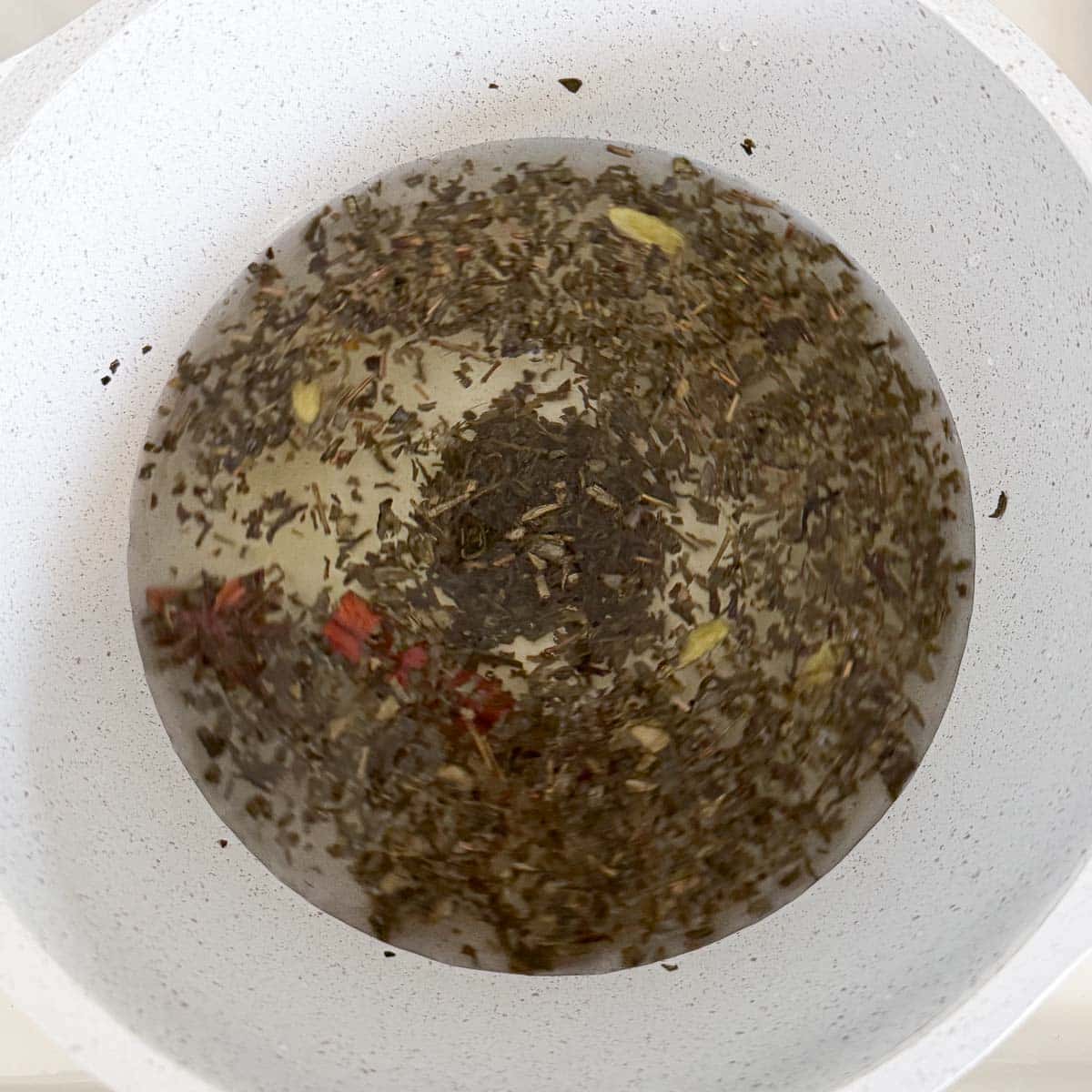
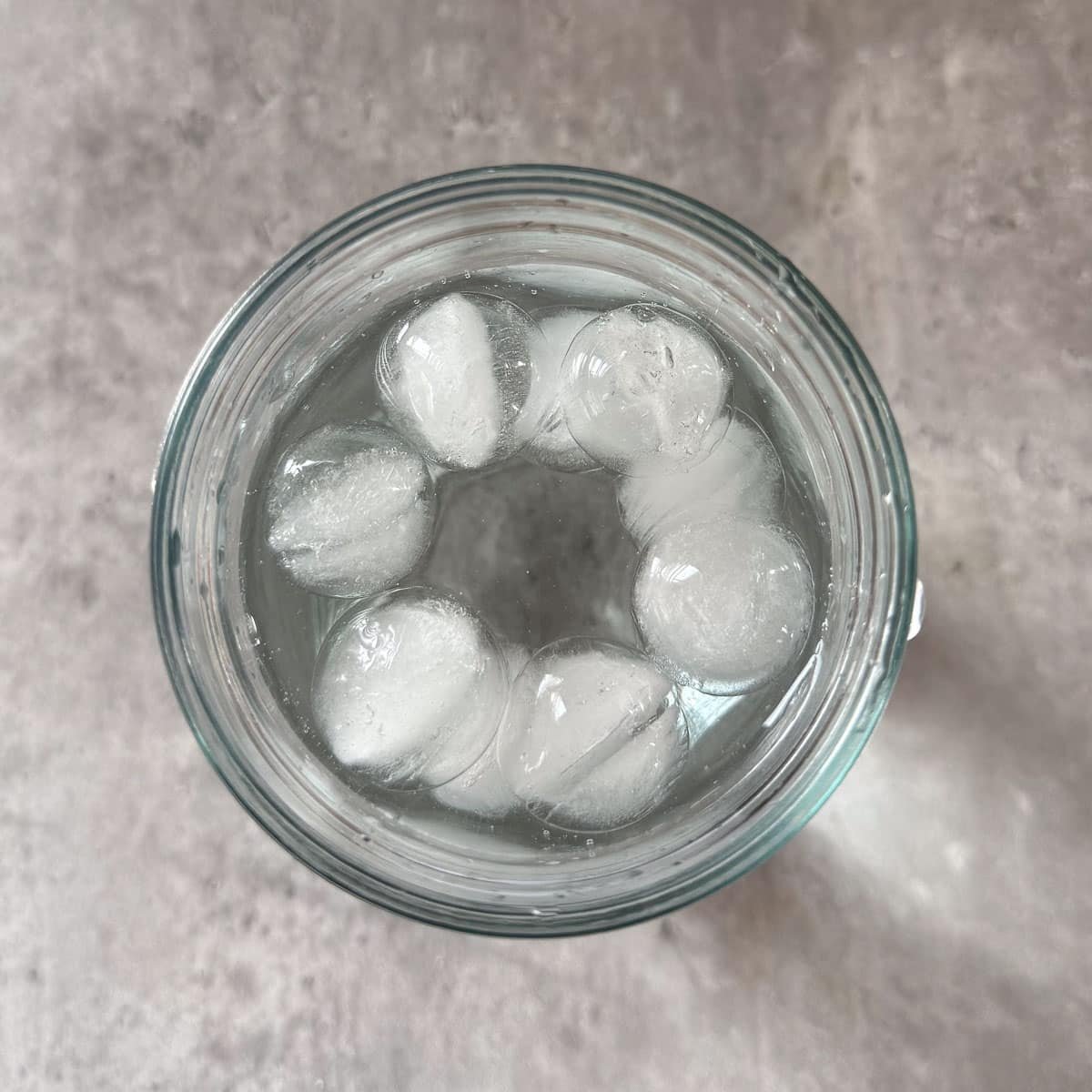
Step 2: Once it begins to boil, add baking soda and salt. Stir and reduce heat to medium-low. Use a ladle to aerate the tea every 60 seconds or so, scooping out the liquid and pouring it back in. This will assist the color change process. Allow the tea to gently boil for 4-6 minutes or until the liquid is reduced by about half and the tea is dark red in color.
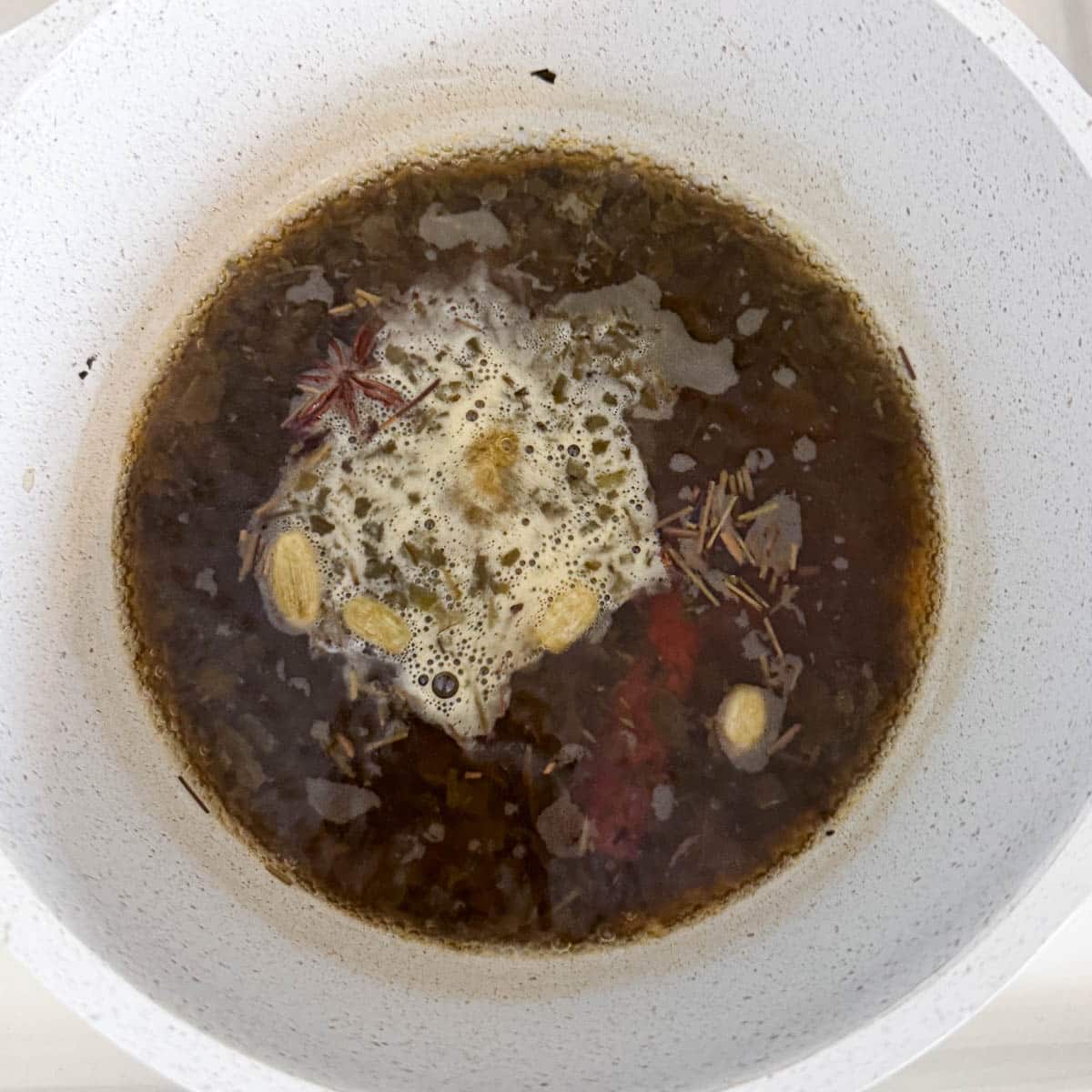
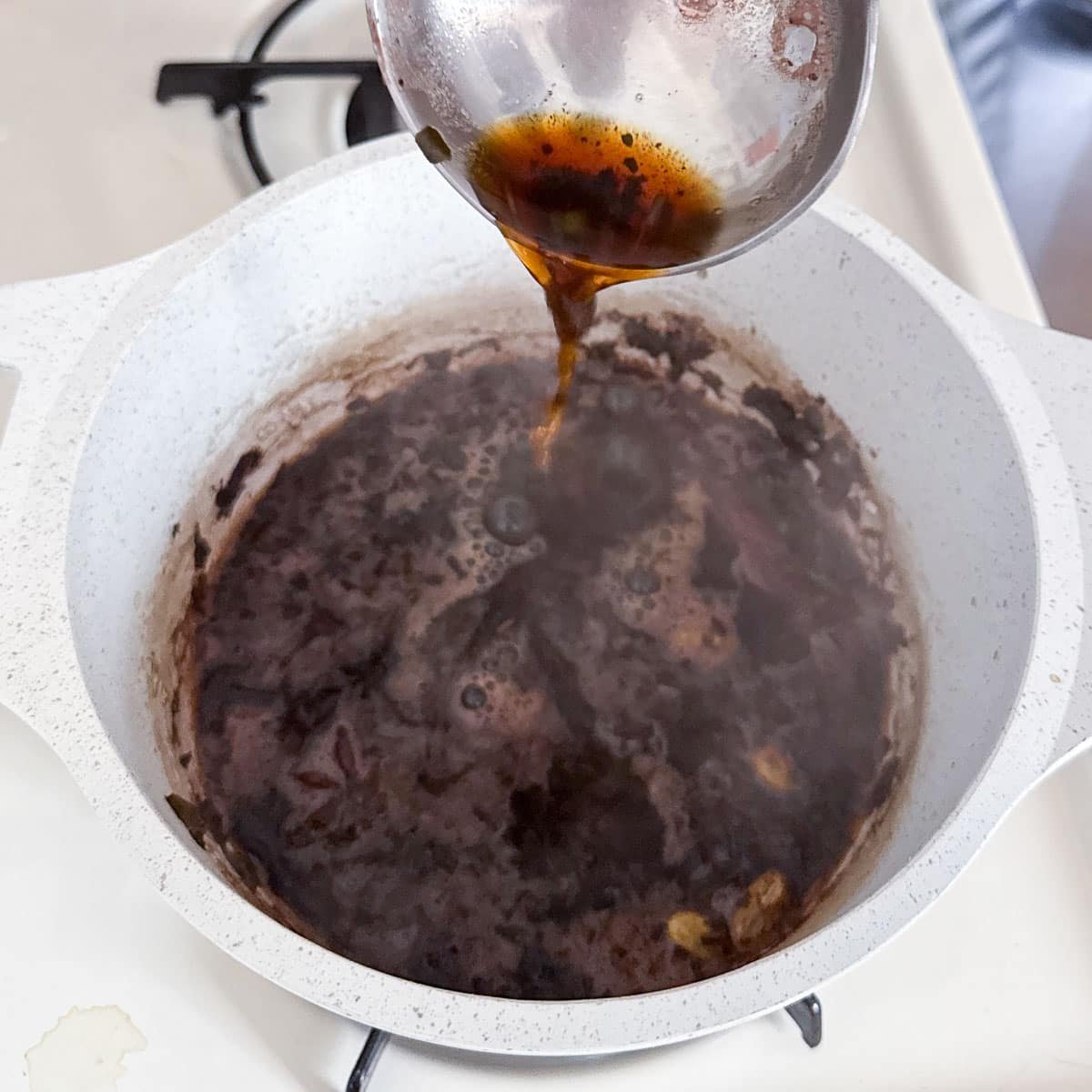
Pro Tip: The baking soda will start to fizz a little when you first add it in - totally fine!
Step 3: When you start to see pink bubbles on the surface of the tea, give it one more stir to confirm it's achieved a deep red color throughout. If so, add the ice water and aerate several more times with the ladle. Slowly add the milk, sugar, and orange blossom water. Bring it back to a gentle boil, then immediately remove from heat.
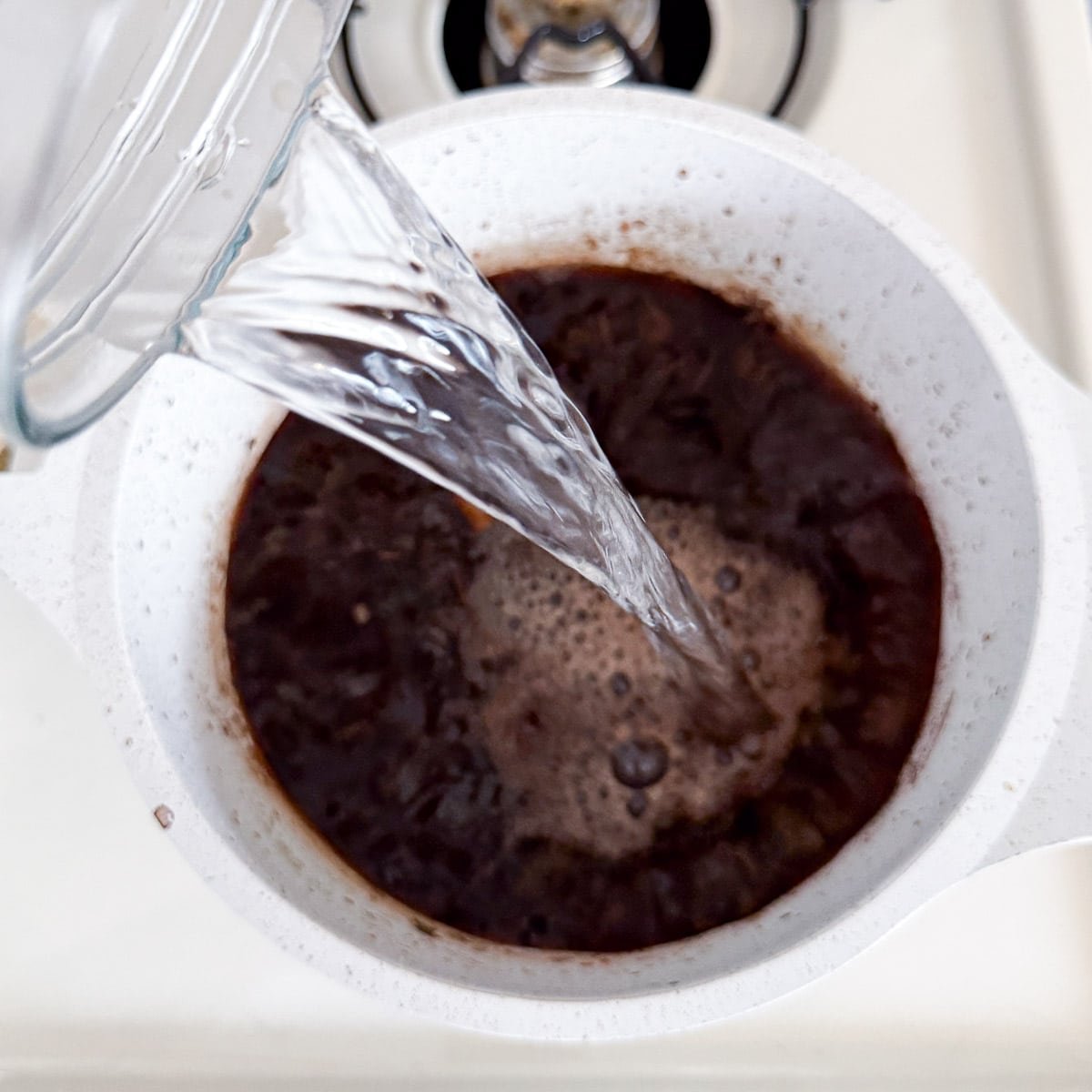
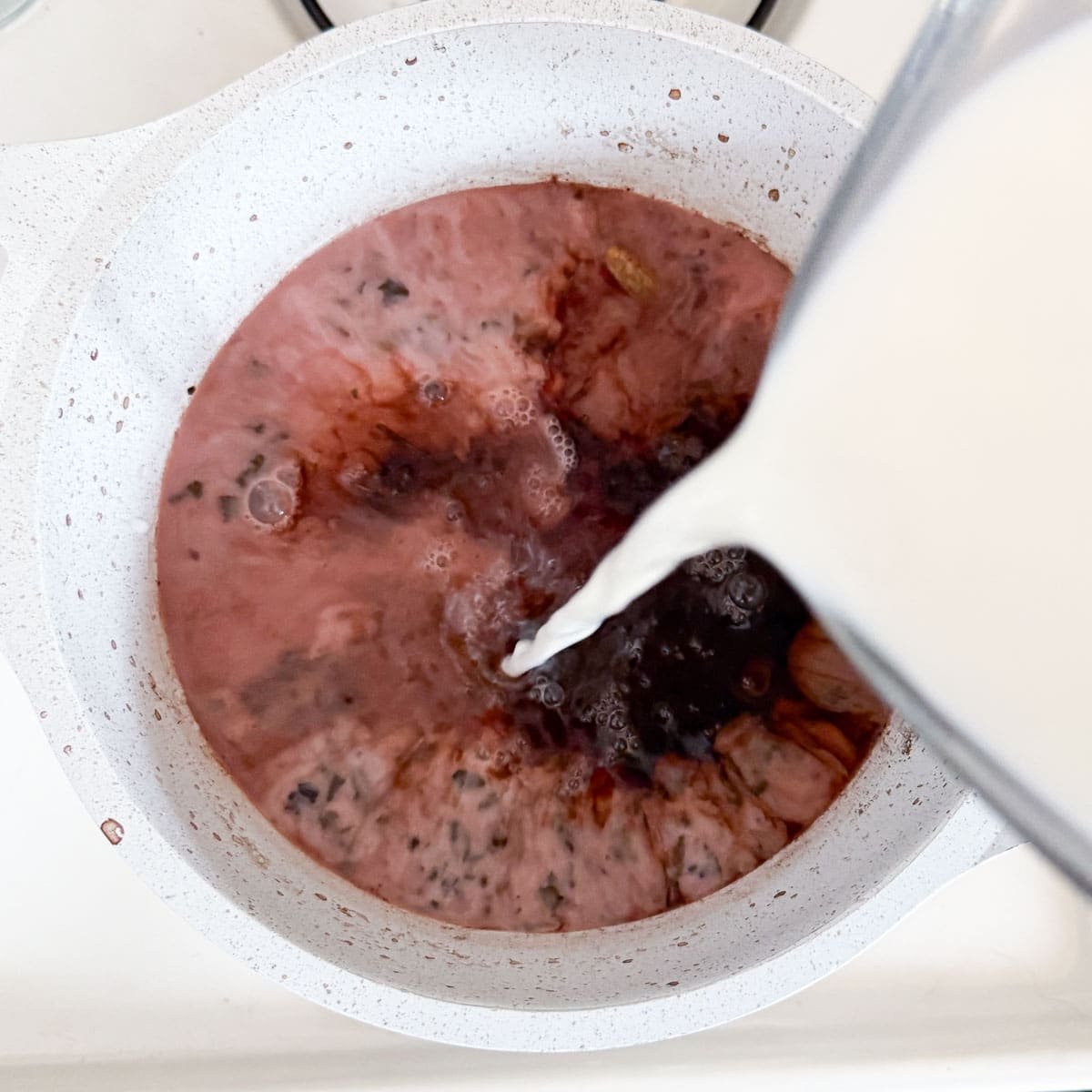
Pro Tip: The ice water creates a rapid temperature drop that "shocks" the tea - in other words, it promotes further aeration and intensifies the color reaction. It also helps prevent the tea leaves from over-steeping!
Would you like to save this recipe?
Step 4: Strain tea and serve topped with chopped pistachios and dried rosehips.
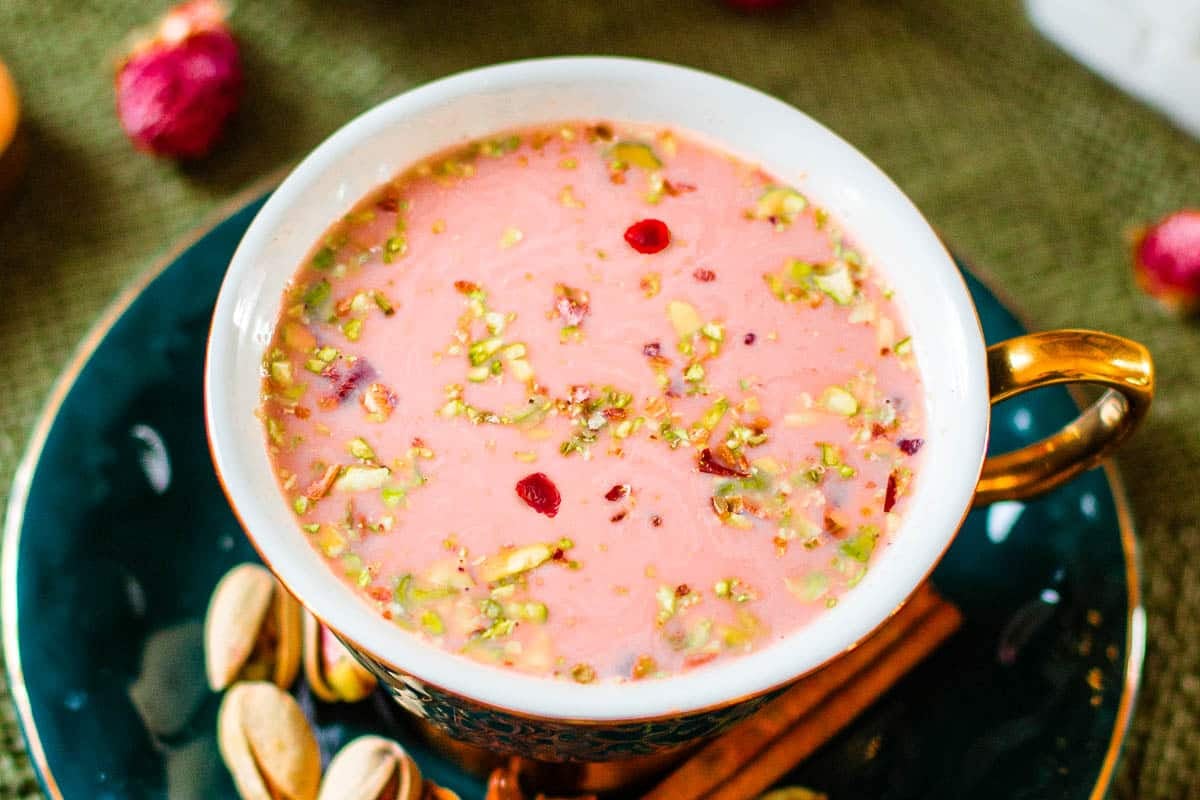
A Rich History
While it's hard to say when exactly the story of Kashmiri chai began, we do know that tea was not widely consumed in the Kashmir region until it was introduced from China along the Silk Road somewhere between the 14th and 16th centuries.
Salt was commonly added to drinks during this time in order to act as an electrolyte to combat dehydration in the high altitudes of the Himalayas.
This Kashmiri pink tea in its modern form was developed several hundred years ago by the Kashmiri people, whose rich traditions existed long before the modern-day borders between India and Pakistan. For this reason, you could say this tea belongs to both Indian and Pakistani cuisines, with some slight regional differences.
🧂 Flavor & Variations
In India, Kashmiri chai is almost always enjoyed as a salty beverage, especially on cold winter mornings.
While it's also prepared as a salty drink in Pakistan, a sweet rendition has also evolved and is commonly enjoyed at weddings and other festive gatherings. Sweet, milky teas are a staple in Pakistan, such as authentic Pakistani chai and doodh patti.
There's no right or wrong way to sweeten this tea - you can use sugar cubes for tea, rose hip syrup, fig syrup, honey syrup, lavender simple syrup, etc.
🩺 Benefits of Kashmiri Pink Tea
Green tea is rich in antioxidants, supports brain function, aids digestion and metabolism, and may help reduce inflammation. See Healthline.com for more info!
Baking soda, in small amounts, can help neutralize stomach acid, relieving acid reflux and indigestion.
Salt can support blood pressure regulation and supply electrolytes, keeping you hydrated.
🥮 Serving Suggestions
If enjoying a salty Kashmiri pink chai, pairing it with savory foods is the way to go. It's commonly served alongside bread, like naan, but I suggest trying it with Iraqi khubz, manakish, or this lavash bread recipe. It would also be a great accompaniment to basturma, shakshuka, Kabak Mücveri, and this Turkish eggs recipe.
The sweetened version of this brew is usually served on its own, but I'd pair it with seviyan, kleicha, nazook, or cardamom cookies.
🤷🏻♀️ Recipe FAQs
When green tea leaves and baking soda are combined in hot water, there's a chemical reaction between the sodium bicarbonate and the chlorophyll in the tea leaves. The result is a deep burgundy liquid, and the addition of milk gives it that lovely shade of pink.
If your Kashmiri chai isn't changing color, you may need to add more baking soda. Remember that the chemical reaction should result in a dark brown or red liquid, and that in order to turn it pink you'll need to add milk.
In Kashmir, pink chai is traditionally a salty milk tea. However, this beverage is also enjoyed in Pakistan and is often sweetened and enjoyed as more of a dessert tea.
You technically might be able to achieve a similar pink color when mixing baking soda with other green teas like sencha or jasmine green tea. However, many green tea varieties are prone to becoming overly bitter if steeped for too long. If you can't find Kashmiri tea leaves, I recommend using Chinese gunpowder tea or Ceylon green tea for the best results!
👩🏻🍳 Pro Tips
- I recommend occasionally stirring the tea throughout the cooking process to keep the leaves from sticking to the bottom of the pot.
- Don't over-boil, especially after adding in the milk, as this will cause it to lose that gorgeous pink shade!
- While Kashmiri chai is traditionally served hot, I recommend trying it served over ice as well!
- Want to make it extra fancy? You can sprinkle a bit of edible glitter over it just before serving.
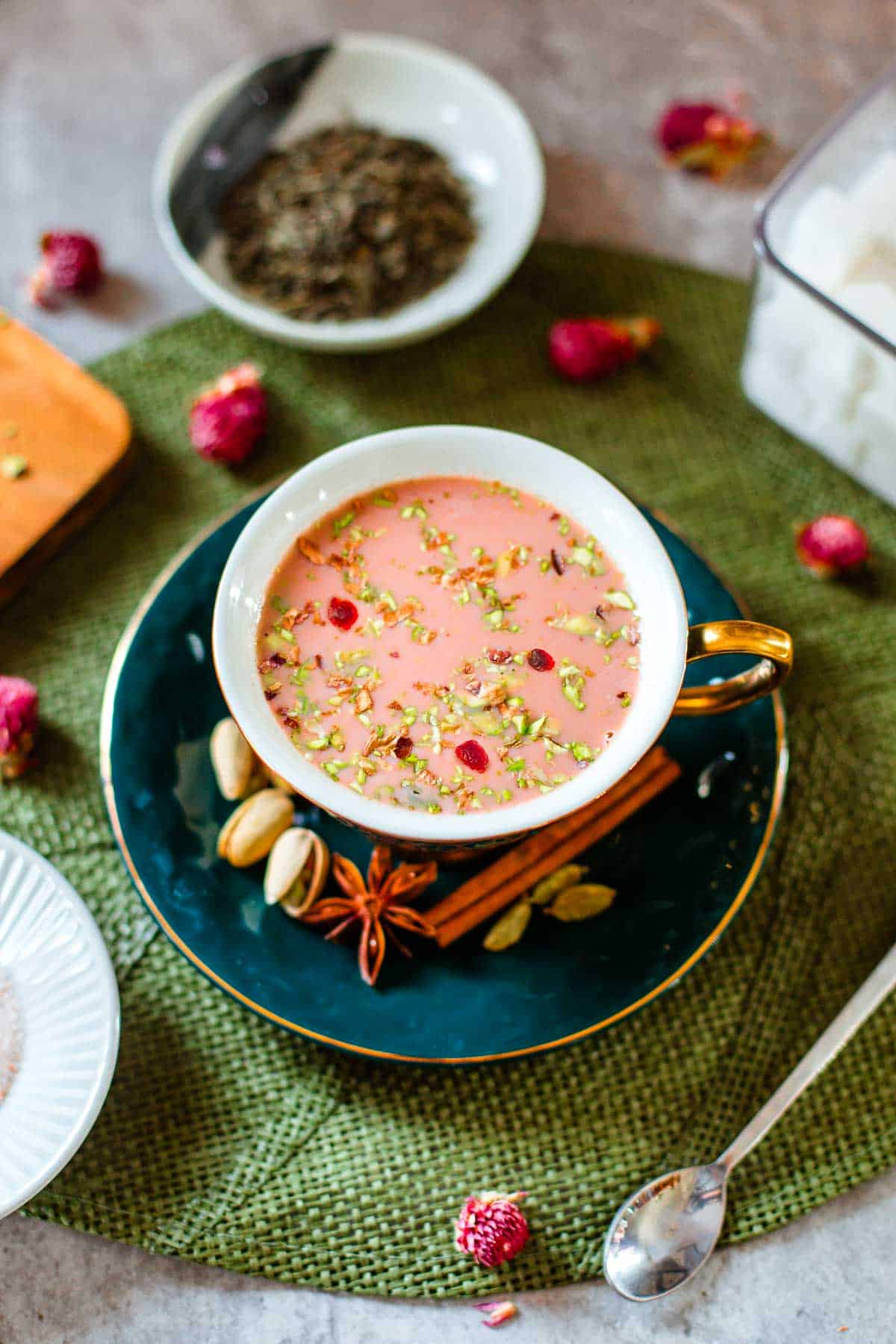
🫖 More Tea Recipes
If you enjoy Kashmiri pink chai, you may also like rosehip tea.
📖 Recipe

Simple Spiced Kashmiri Pink Chai
Ingredients
Method
- Add 2 cups water to a medium saucepan, along with Kashmiri chai leaves, cardamom pods, star anise, and a cinnamon stick. Stir and bring to a boil. Meanwhile, prepare the ice water.
- Once it begins to boil, add baking soda and salt. Stir and reduce heat to medium-low. Use ladle to aerate the tea every 60 seconds or so, scooping out the liquid and pouring it back in. This will assist the color change process. Allow the tea to gently boil for 4-6 minutes or until liquid is reduced by about half and tea is dark red in color.
- When you start to see pink bubbles on the surface of the tea, give it one more stir to confirm it's achieved a deep red color throughout. If so, add the ice water and aerate several more times with the ladle. Slowly add in the milk, sugar, and orange blossom water. Bring it back to a gentle boil, then immediately remove from heat.
- Strain tea and serve topped with chopped pistachios and dried seedless rosehips.
Nutrition
Notes
- The baking soda will start to fizz a little when you first add it in - totally fine!
- The ice water creates a rapid temperature drop that "shocks" the tea - in other words, it promotes further aeration and intensifies the color reaction. It also helps prevent the tea leaves from over-steeping!
- I recommend occasionally stirring the tea throughout the cooking process to keep the leaves from sticking to the bottom of the pot.
- Don't over-boil, especially after adding in the milk, as this will cause it to lose that gorgeous pink shade!
- While Kashmiri chai is traditionally served hot, I recommend trying it served over ice as well!
- Want to make it extra fancy? You can sprinkle a bit of edible glitter over it just before serving.

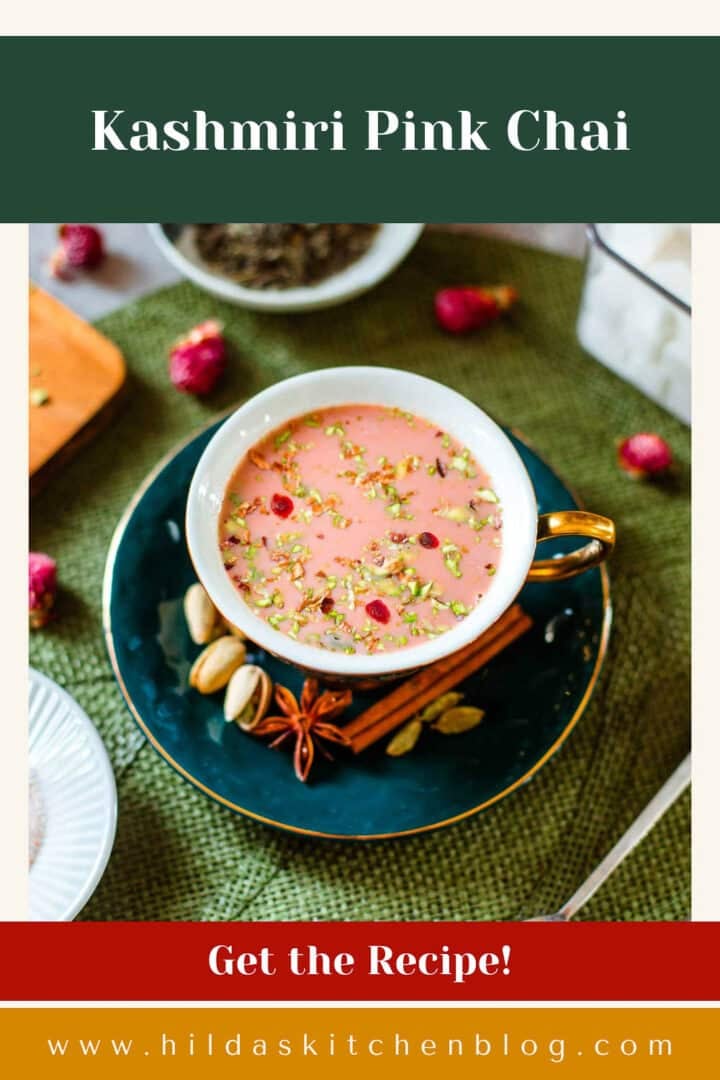
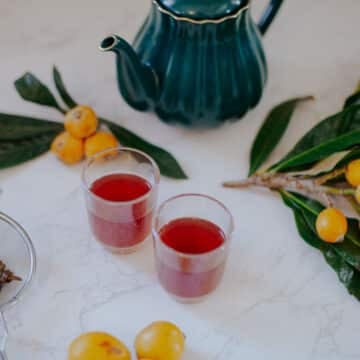
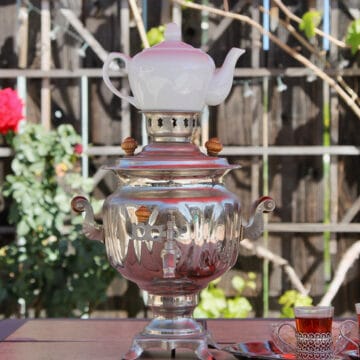
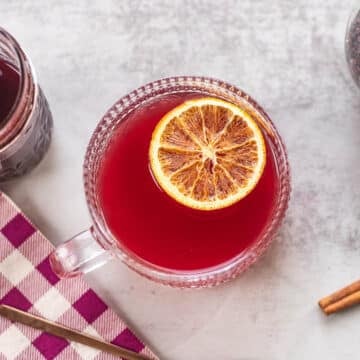

Shala Carter says
ooooooooo, This looks like something I need to have my son try. He's the only one in the house who can stand long enough to do the stirring. 😉
Shalam!
Hilda Sterner says
Yes, this one requires standing, make the youngins do it! 😜
Nena Sterner says
We hope you enjoy this recipe as much as we do!